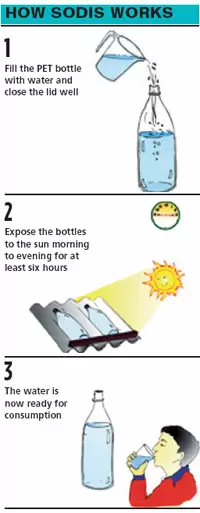Solar water disinfection is a low-cost water treatment method wherein lime plays a role

01-June-2012
Vol 3 | Issue 22
Solar Water Disinfection or SODIS, an effective, low-cost water treatment method, has been around for several years.
It works on the principle that adequate exposure of water to sunlight deactivates microorganisms. But it takes long to purify water this way and this limits the use of this method.
 |
Usually, a polyethylene terephthalate (PET) bottle filled with water has to be exposed to sunlight for six hours under normal sunlight and 48 hours on cloudy days.
A research has found that adding lime juice can cut down the time taken for purification drastically. It takes 30 minutes on a normal day and an hour on a cloudy day.
The researchers at Johns Hopkins Bloomberg School of Public Health and Medicine in the US say this is because of the presence of psoralen, a class of phytoactive biomolecules that have been used for long to sterilise blood plasma and platelets. Psoralen occurs naturally in various plants, including citrus fruits, figs, celery, parsley and Indian satinwood.
In the SODIS method, solar ultra-violet radiation, UV, is the main driver. UV activates dissolved organic carbon, which then releases reactive oxygen, which cause cellular damage in the microbes and inactivates them.
Similarly, in the presence of UV light, peaking near a wavelength of 365 nanometre (nm), like from the sun, psoralens form covalent bonds with the DNA of the microbe and prevent replication of the genetic material.
PET bottles that are used are highly transmissive to 365 nm light, and thus enable the psoralens to retain their photoreactive effect inside the bottle.
When asked why glass bottles could not be used in place of plastic that has toxins, Kellogg Schwab, the lead researcher said, “Glass bottles block specific wavelengths of sunlight needed for the treatment.”
The team found that for a two-litre PET bottle, 30 ml of lime juice is sufficient. This roughly corresponds to juice from three-quarters of a lemon. Thirty- minute exposure of this water can reduce the number of Escherichia coli bacteria by one million times.
The study was published in the April 2012 issue of American Journal of Tropical Medicine and Hygiene. But did not the lime flavour water? “Yes, it did,” said Schwab.
“We are working on a dosage level for lime that would not flavour the water but effectively treat it.”
Lime juice is not the only natural product that has been used for cleaning water. In a study published in February in Journal of Natural Products, it was shown that Moringa oleifera (drumstick) seed can be used as natural absorbent and anti-microbial agent in drinking water. The seed contains benzyl isothiocyanate and benzyl glucosinolate that help clean water.
By arrangement with Down to Earth















